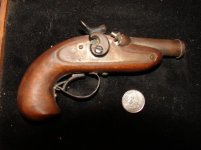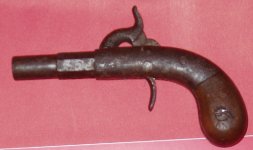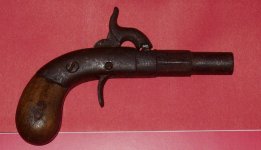You are using an out of date browser. It may not display this or other websites correctly.
You should upgrade or use an alternative browser.
You should upgrade or use an alternative browser.
What Cap-n-Ball Derringer is this?
- Thread starter Gehrhard
- Start date
Jim Watson
New member
I think it looks like something assembled out of spare parts, it does not resemble any period derringer that I have seen.
robhof
Ok how about this; came with some guns bought from a widow, no history; 38cal, no trigger guard or return spring for trigger(I suspect they are one unit as in some underhammer models) and yes it does shoot; tested with 10gr 3f Goex and prb, smoothbore.
Ok how about this; came with some guns bought from a widow, no history; 38cal, no trigger guard or return spring for trigger(I suspect they are one unit as in some underhammer models) and yes it does shoot; tested with 10gr 3f Goex and prb, smoothbore.
Attachments
robhof
Judging by it's quality, mine must be Belgian, as it's not quality work and as far as marks, I've found none. I did take it apart and found no contact points or grooves for a trigger return spring. After a test firing tied to a 2"x4" I've fired it a few times, just because I could and I had nothing invested in it, but some time.

Judging by it's quality, mine must be Belgian, as it's not quality work and as far as marks, I've found none. I did take it apart and found no contact points or grooves for a trigger return spring. After a test firing tied to a 2"x4" I've fired it a few times, just because I could and I had nothing invested in it, but some time.
bedbugbilly
New member
Trigger spring? The sear on a lock usually is what provides any "spring" as when the lock is cocked, that is what takes up the "slack" - usually the trigger is either one assempley with the trigger being pinned into the trigger plate or it is pinned into the trigger mortise through the stock - sometimes with a separate trigger plate or no trigger plate at all.
I'd be curious to know where some of you are coming up with a "trigger spring"? This isn't a "single set" trigger and it sure isn't a "double set" trigger.
The lock looks like it is off of an old breechloading shotgun. Is the hammer nose recessed for the nipple or does it just strike against the nipple?
This has all the appearances of being a "marriage of parts". Not a bad job though.
I'd be curious to know where some of you are coming up with a "trigger spring"? This isn't a "single set" trigger and it sure isn't a "double set" trigger.
The lock looks like it is off of an old breechloading shotgun. Is the hammer nose recessed for the nipple or does it just strike against the nipple?
This has all the appearances of being a "marriage of parts". Not a bad job though.
bedbugbilly
New member
My apologies on the "trigger spring" - I didn't catch the photos of the second pistol. I was talking about the first pistol pictured.
On the second pistol - I had one very similar to this. It was a screw barrel and it had no proof marks. The only markings that were on mine were "cast steel" - I always figured that it was probably Belgium. On the one I had, the barrel was round up to where it screwed on to the breech casting and it transitioned into octogon at that point. It would have required a wrench that slide over the end of the barrel and utilized the octogon portion to unscrew it for loading. Not all, but a good majority of the screw barrel pistols often had a bullet mold furnished with the wrench on the end of one of the handles. I have a small bullet mold that was passed down through my family that has a square lug on the end of the handle at a right angle - this was to slip into the end of the barrel that would have had "octogon rifling" to unscrew the barrel for loading. Many of the screw barrels had a cupped breech which took only so many grains of powder and the ball was set on top of the charge. The barrel was then screwed on - the ball being just enough oversize of the rifling that when the barrel was tightened down, the ball "stayed put" when the rifling in the end of the breech of the barrel tightened down on it. Patches wee not commonly used - these were strictly for "up close" use.
On the second pistol - I had one very similar to this. It was a screw barrel and it had no proof marks. The only markings that were on mine were "cast steel" - I always figured that it was probably Belgium. On the one I had, the barrel was round up to where it screwed on to the breech casting and it transitioned into octogon at that point. It would have required a wrench that slide over the end of the barrel and utilized the octogon portion to unscrew it for loading. Not all, but a good majority of the screw barrel pistols often had a bullet mold furnished with the wrench on the end of one of the handles. I have a small bullet mold that was passed down through my family that has a square lug on the end of the handle at a right angle - this was to slip into the end of the barrel that would have had "octogon rifling" to unscrew the barrel for loading. Many of the screw barrels had a cupped breech which took only so many grains of powder and the ball was set on top of the charge. The barrel was then screwed on - the ball being just enough oversize of the rifling that when the barrel was tightened down, the ball "stayed put" when the rifling in the end of the breech of the barrel tightened down on it. Patches wee not commonly used - these were strictly for "up close" use.



